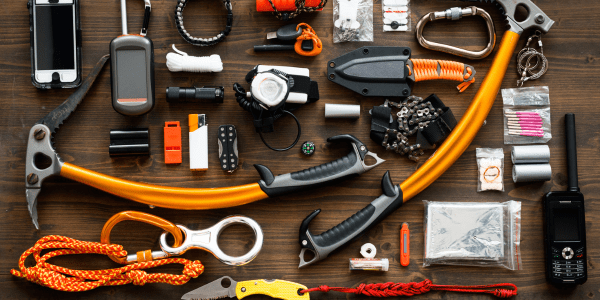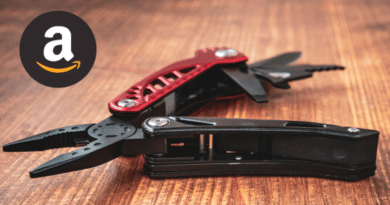Bug-Out Bags: Essential Preparedness for Uncertain Times
In an unpredictable world, being prepared for unexpected emergencies is essential. Bug-out bags (BOB) are a portable survival kit designed to provide you with the necessary supplies and equipment to sustain yourself during a crisis or when you need to evacuate quickly.
A survey of 800 people revealed that only 25% of those in this group had bug-out bags. Additionally, even the mainstream media finds that more and more Americans are prepping for extreme catastrophes. Personally, I think that’s a good idea with everything going on in the world today, along with the chaos in the streets here in the US.
That said, it’s important to be prepared but not paranoid. You shouldn’t live your life thinking any moment something is going to happen to you and be on edge. Having a bug-out bag is more of a “good to have it and not need it than need it and not have it.”
Related Article: Are You Prepared for a Disaster with an Emergency Food Supply?
This article will dive deeper and explore what bug-out bags are, why having one is crucial, and provide a comprehensive checklist of items to include or consider putting in your bug-out bags.
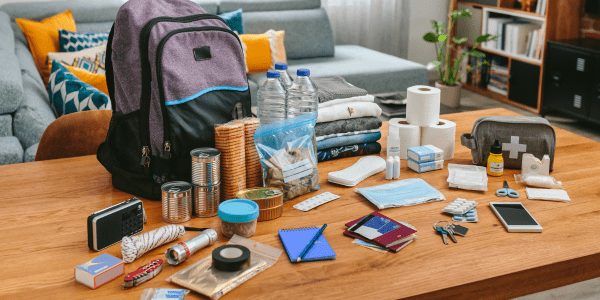
Table of contents
- What Are Bug-Out Bags?
- What Kind of Bug-Out Bags Should You Purchase?
- Why Would You Need a Bug-Out Bag?
- What Items Should You Include in Bug-Out Bags?
- What are Some Considerations When Building Bug-Out Bags?
- Want to Learn How to Create a 72-Hour Strategy and What You Need in Bug-Out Bags?
- The Best Time to Start Building Bug-Out Bags is Right Now
What Are Bug-Out Bags?
A bug-out bag, also known as a go-bag, 72-hour kit, or emergency kit, is a pre-packed backpack or duffel bag filled with essential items needed to support your survival and basic needs during emergencies. Its purpose is to enable individuals or families to quickly and efficiently evacuate their homes or survive in adverse conditions.
What Kind of Bug-Out Bags Should You Purchase?
You don’t need a doomsday prepper to have your home in order and have preps. Any urban survivalist or modern prepper (and everyday people) can benefit from having a bug-out bag.
A bug-out bag is designed to carry essentials in a scenario where you would need to leave your home in a hurry. While there is no definitive answer to what makes the absolute best bug-out bag, there are certain factors to consider when assembling one.
Related Article: From Chaos to Calm — An Essential Get Home Bag Guide
Each bug-out bag tends to differ slightly based on individual wants, needs, and necessities. However, it’s critical to have a good bug-out bag that is made of excellent materials so that you don’t run into an issue where the bug-out bag starts to break down on you while trying to leave or escape an emergency.

Here are some considerations when looking to purchase a bug-out bag:
1. Durability of Bug-Out Bags
Look for bug-out bags made from durable materials such as nylon or Cordura. These materials are known for their strength and resistance to tearing, making them suitable for withstanding rugged conditions.
2. Size and Capacity of Bug-Out Bags
Choose a bag that is spacious enough to hold all the essential items you plan to carry but not so large that it becomes unwieldy. Depending on your needs, a capacity of around 30 to 50 liters is often recommended. Something to remember is that ounces equal pounds, and pounds equal pain. Moving long distances with a heavy pack on your back can definitely cause pain throughout your body if you’re not accustomed to carrying such a weight.
3. Organization
Look for a bag with multiple compartments and pockets, both internally and externally. This allows for better organization and easy access to specific items when needed. The key should be to know where everything is and that everything has its place in your bug-out bag.
4. Comfort
Bug-out bags can become heavy when carrying many items, so it’s important to consider comfort. Look for a bag with padded shoulder straps and a back panel for improved comfort during extended periods of carrying. A chest strap and hip belt can also help distribute the weight more evenly and reduce strain on your shoulders. In my opinion, these are all a must, as a standard backpack with shoulder straps will have you regret your life decisions shortly after bugging out.
5. Water Resistance
While not essential, having a bag with water-resistant or waterproof materials can help protect your supplies from moisture in case of rain or other wet conditions. You can purchase specific waterproof bags or simply use a Ziplock bag to put your items in to keep them organized and dry.
6. Versatility
Consider a bug-out bag that offers versatility in terms of attachment points or compatibility with additional modular pouches or gear. This allows you to customize and expand your kit as needed. This isn’t 100% necessary, but it’s a nice option to have.
7. Accessibility of Bug-Out Bags
Ensure the bag has easy-access features like quick-release buckles or zippers, enabling you to quickly reach important items without having to dig through the entire bag.
Below are some recommended bug-out bag options that are of good quality:
- 5.11 Rush 24 Backpack
- 5.11 Tactical Military Rush 100 Backpack
- Vertx Ready Pack 2.0
- Vertx Gamut Overland Pack
- Eberlestock Bandit Pack
Why Would You Need a Bug-Out Bag?
If you’re reading this, chances are you understand the need for something like a bug-out bag. For everyone else, they look at us as if we are wearing tinfoil hats and that we are some sort of conspiracy theorist. It’s ok. It’s better to be prepared than unprepared, in my opinion.
Related Article: Sweet Survival — The Many Benefits of Honey for Preppers
Below are some scenarios where you may need to leave your home quickly, and your bug-out bag would be required to provide you with the survival items needed while you find a new location to stay safe.
1. Natural Disasters
Earthquakes, hurricanes, floods, or wildfires can occur unexpectedly, forcing you to leave your home in a hurry. A bug-out bag ensures you have vital supplies within reach when access to resources is limited.
2. Civil Unrest or Evacuation
In cases of civil unrest, political instability, or mandatory evacuation orders, having a bug-out bag can offer peace of mind and enhance your ability to respond swiftly by food, vehicle, or even e-bike.
3. Personal Emergencies
A bug-out bag is also useful for personal emergencies like sudden job loss or unexpected travel, ensuring you have the essentials to meet your immediate needs until stability is regained.
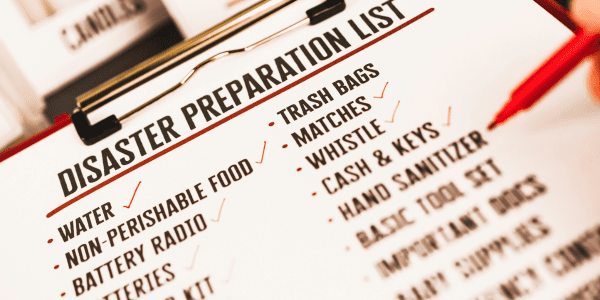
What Items Should You Include in Bug-Out Bags?
Below are some considerations that you can use as somewhat of a checklist to ensure you have the proper gear and items in your bug-out bags. These items should help prepare you for several situations.
1. Water and Hydration
- Water bottles or collapsible water pouches (at least 1 liter per day)
- Water purification tablets or filtration system
- Reusable water container
2. Food and Nutrition
- Non-perishable food items (energy bars, dried fruits, nuts)
- Nutrition or protein bars
- Utensils (disposable or reusable)
3. Shelter and Clothing
- Lightweight tent or tarp
- Sleeping bag or emergency blanket
- Extra clothing (including sturdy shoes, extra socks, and rain gear)
- Winter hat (season/temperature dependent)
- Baseball hat
- Bandana
4. First Aid and Medical Supplies
- First aid kit with essential supplies (bandages, antiseptic wipes, pain relievers)
- Prescription medications (if applicable)
- Personal hygiene items (toothbrush, toothpaste, soap, deodorant, hand sanitizer, etc.)
5. Tools and Equipment
- Multi-tool
- Flashlight or headlamp with spare batteries
- Fire-starting tools (matches, lighters, firestarter)
- Whistle for signaling
- Duct tape and paracord
- Entrenching tool
- Survival fishing kit
6. Communication and Navigation
- Battery-powered or hand-crank radio
- Signaling mirror
- Compass or GPS device
- Local maps
- Rite in the Rain notepad and Pen
7. Personal Documents and Cash
- Identification documents (passports, driver’s licenses, etc.)
- Copies of important documents (birth certificates, insurance policies)
- Emergency cash (including small bills and coins)
8. Miscellaneous Items
- Multi-purpose survival knife
- Extra batteries
- Portable phone charger or solar charger
- Sewing kit
- Entertainment (deck of cards, books, or puzzles)
I have found that putting each of the sections mentioned above in their own Ziplock bag makes for great organization and keeps water from damaging the contents. You can purchase special waterproof bags if you wish, but I haven’t had any issues with Ziplock from my testing.
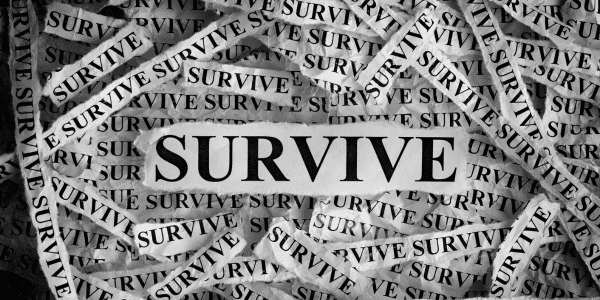
What are Some Considerations When Building Bug-Out Bags?
Building out a bug-out bag can somewhat be like rolling the dice since you don’t have a crystal ball looking into the future. What scenario will most likely happen so that I know what to pack? Unfortunately, it could be potential scenarios, and therefore, you need to pack items that would serve to sustain you through various events and scenarios.
Related Article: CBRN Gas Mask — A Key to Survival for You & Your Family
Below are some considerations you should think about when building bug-out bags:
1. Duration of Emergency
Consider the potential duration of the emergency when packing your bug-out bag. While a 72-hour kit is a typical recommendation, it’s wise to include supplies that can sustain you for a longer period, such as extra food, water (having a Sawyer Mini in your bug-out bag is essential), and clothing.
2. Personalization of Bug-Out Bags
Customize your bug-out bags according to your specific needs and circumstances. Consider factors like climate, geographic location, the number of individuals in your party, and any specific medical or dietary requirements.
3. Family and Pet Considerations
If you have family members or pets that live with you, ensure you also have supplies for them. Include necessary items such as baby food, diapers, medications, pet food, leashes, and any comfort items that may help alleviate stress during challenging times.
4. Regular Inspection and Rotation
Regularly inspect and refresh the contents of your bug-out bags. Check expiration dates on food, medications, and batteries, and replace them as needed. Update any documents or personal information if necessary.
5. Physical Fitness and Training
Having a bug-out bag is just one part of emergency preparedness. Maintain good physical fitness and consider acquiring basic survival skills like first aid, navigation, and self-defense. Regularly practice using the equipment in your bug-out bag to ensure familiarity and proficiency.
6. Storage and Accessibility of Your Bug-Out Bags
Store your bug-out bags in an easily accessible location known to all household members. Ensure everyone knows its location and how to retrieve it quickly in case of an emergency. Consider additional storage options like waterproof bags or containers to protect your supplies from the elements.
7. Communication and Emergency Plans
Establish communication protocols and emergency plans with your family or household members. Designate meeting points or establish a communication plan using a designated person outside the affected area. Include relevant contact information, emergency phone numbers, and important addresses in your bug-out bag.
8. Evacuation Routes
Familiarize yourself with evacuation routes in your area, and keep maps or GPS devices handy in your bug-out bags. Be aware of alternate routes and have a backup plan if primary routes are inaccessible.
Remember, a bug-out bag is just one aspect of emergency preparedness. It’s essential to stay informed about potential risks, monitor news and weather updates, and have a comprehensive emergency plan in place for yourself and your family.
Related Article: Ferro Rods in Survival Kits — Why Every Prepper Should Have One
By considering these additional factors, you can enhance your preparedness and readiness to face any unexpected situation that may arise.
Want to Learn How to Create a 72-Hour Strategy and What You Need in Bug-Out Bags?
If you got some good information from this article but want even more from professionals who know way more than me, check out the Tremis Dynamics Bug Out Primer class. The great thing about this class is that you don’t have to know anything about how to bug out, what to put in bug-out bags, and all you need to bring with you is an open mind and note-taking material. It’s a 3+ hour seminar that will help you build a contingency plan for in the event you need to leave your home.
The goal of the class is to help you create a 72-hour strategy and the gear you’ll need to survive. Not only will you learn the strategies and gear needs, but also the mindset to thrive in such a chaotic scenario.
I thought I had a good setup until I went to this class and realized that I probably have too much in my bug-out bag and that some of the stuff I have in the bag may not be the right option or tool to get the job done that I need it to do. Additionally, I checked out the Kelty Redwing 50 and decided to pick it up as my new dedicated bug-out bag.
We got to look at several packs, different sleep systems, the contents of different bug-out bags and packs, and things you need to do and think about when moving from Point A to Point B when you’re bugging out.
And of course, one of the best tools that everyone is looking for from such a class is you get a gear list of all the items you need to consider packing and keeping in your bug-out bags. You don’t need to have any experience to take the class and we had people from all walks of life in the class. Everyone from middle-aged women with kids to ex-military and police (and everyone in-between).
I highly recommend this class and it’s priced so low that it’s affordable for everyone. Go check it out. You won’t regret it.
The Best Time to Start Building Bug-Out Bags is Right Now
I don’t want this bug-out bag article to frighten you into having you live your day-to-day lives in fear — that’s not the purpose. But if you’re someone who works on their fitness, you’re not doing it because something has already happened to your health or you think you’ll get some sort of disease down the road. You exercise to prevent things and get ahead of the curve.
The same can be said about carrying a firearm as part of your EDC (everyday carry). You don’t leave the house thinking you’re going to encounter a threat, you carry it in case such a situation arises, and you need to defend yourself against someone attempting to kill you.
Related Article: Is the Sig Sauer P365X the Best Concealed Carry Firearm?
Having a well-equipped bug-out bags can significantly increase your chances of survival and comfort during unforeseen emergencies. By gathering the essential items listed above and customizing your bag according to personal needs, you’ll be prepared to face adversity and safeguard your well-being in times of crisis.
Remember to regularly review and update your bug-out bags to ensure its contents are up-to-date and relevant to your situation. Stay prepared, stay safe.
As a side note to close out this article, if you want to support our website and are in need of any tactical gear (or any product for that matter), anything you purchase using our links below will provide us with a small commission. We don’t charge for our free content and our goal is to keep it that way. We don’t have a Patreon account to put things behind a paywall, nor do we sell pics of our feet on OnlyFans.
If you choose to use the links below and make a purchase (at no additional cost to you), we greatly appreciate your support as it helps us continue to publish free content (like this article) on our website:
- Optics Planet (use code SAS5 at checkout for 5% off)
- Amazon
We have also partnered with CCW Safe. It’s the concealed carry coverage that I personally have for myself and my family in the event we need to defend our lives. Feel free to use our CCW Safe link to sign up and get some coverage to protect yourself and your family.
Also if you have a product you would like us to check out and potentially review, please contact us and let’s discuss.


